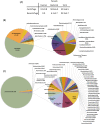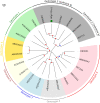Deep viral blood metagenomics reveals extensive anellovirus diversity in healthy humans
- PMID: 33767340
- PMCID: PMC7994813
- DOI: 10.1038/s41598-021-86427-4
Deep viral blood metagenomics reveals extensive anellovirus diversity in healthy humans
Abstract
Human blood metagenomics has revealed the presence of different types of viruses in apparently healthy subjects. By far, anelloviruses constitute the viral family that is more frequently found in human blood, although amplification biases and contaminations pose a major challenge in this field. To investigate this further, we subjected pooled plasma samples from 120 healthy donors in Spain to high-speed centrifugation, RNA and DNA extraction, random amplification, and massive parallel sequencing. Our results confirm the extensive presence of anelloviruses in such samples, which represented nearly 97% of the total viral sequence reads obtained. We assembled 114 different viral genomes belonging to this family, revealing remarkable diversity. Phylogenetic analysis of ORF1 suggested 28 potentially novel anellovirus species, 24 of which were validated by Sanger sequencing to discard artifacts. These findings underscore the importance of implementing more efficient purification procedures that enrich the viral fraction as an essential step in virome studies and question the suggested pathological role of anelloviruses.
Conflict of interest statement
The authors declare no competing interests.
Figures





Similar articles
-
Exploring the Diversity of the Human Blood Virome.Viruses. 2021 Nov 21;13(11):2322. doi: 10.3390/v13112322. Viruses. 2021. PMID: 34835128 Free PMC article.
-
Plasma Virome Reveals Blooms and Transmission of Anellovirus in Intravenous Drug Users with HIV-1, HCV, and/or HBV Infections.Microbiol Spectr. 2022 Aug 31;10(4):e0144722. doi: 10.1128/spectrum.01447-22. Epub 2022 Jun 27. Microbiol Spectr. 2022. PMID: 35758682 Free PMC article.
-
Human Anelloviruses: Influence of Demographic Factors, Recombination, and Worldwide Diversity.Microbiol Spectr. 2023 Jun 15;11(3):e0492822. doi: 10.1128/spectrum.04928-22. Epub 2023 May 18. Microbiol Spectr. 2023. PMID: 37199659 Free PMC article.
-
Anelloviruses versus human immunity: how do we control these viruses?FEMS Microbiol Rev. 2024 Jan 12;48(1):fuae005. doi: 10.1093/femsre/fuae005. FEMS Microbiol Rev. 2024. PMID: 38337179 Free PMC article. Review.
-
Human anelloviruses: diverse, omnipresent and commensal members of the virome.FEMS Microbiol Rev. 2020 May 1;44(3):305-313. doi: 10.1093/femsre/fuaa007. FEMS Microbiol Rev. 2020. PMID: 32188999 Free PMC article. Review.
Cited by
-
A Case of Persistent Human Pegivirus Infection in Two Separate Pregnancies of a Woman.Microorganisms. 2022 Sep 28;10(10):1925. doi: 10.3390/microorganisms10101925. Microorganisms. 2022. PMID: 36296201 Free PMC article.
-
Virome of Giant Panda-Infesting Ticks Reveals Novel Bunyaviruses and Other Viruses That Are Genetically Close to Those from Giant Pandas.Microbiol Spectr. 2022 Aug 31;10(4):e0203422. doi: 10.1128/spectrum.02034-22. Epub 2022 Aug 2. Microbiol Spectr. 2022. PMID: 35916407 Free PMC article.
-
Exploring the Diversity of the Human Blood Virome.Viruses. 2021 Nov 21;13(11):2322. doi: 10.3390/v13112322. Viruses. 2021. PMID: 34835128 Free PMC article.
-
Detection and genetic characterization of the novel torque teno virus group 6 in Taiwanese general population.R Soc Open Sci. 2021 Nov 3;8(11):210938. doi: 10.1098/rsos.210938. eCollection 2021 Nov. R Soc Open Sci. 2021. PMID: 34737877 Free PMC article.
-
Blood DNA virome associates with autoimmune diseases and COVID-19.Nat Genet. 2025 Jan;57(1):65-79. doi: 10.1038/s41588-024-02022-z. Epub 2025 Jan 3. Nat Genet. 2025. PMID: 39753770 Free PMC article.
References
Publication types
MeSH terms
LinkOut - more resources
Full Text Sources
Other Literature Sources
Medical

